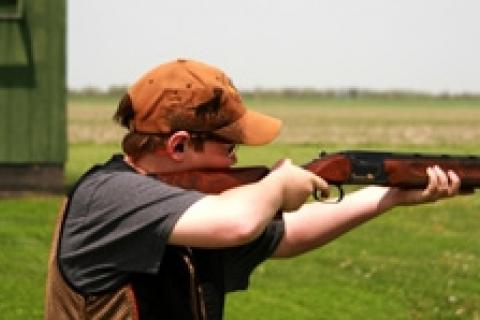
As the bird reached its cruising altitude, my finger slapped the trigger — I felt the recoil on my shoulder and I watched as the wad passed harmlessly behind the clay pigeon. Ten more yards and the pigeon lost the battle with gravity and fell to Earth, untouched. At the next station, I was ready; I called for a bird — it erupted from the trap house putting distance between us. My front sight passed the bird; while my finger had the desire to slap the trigger, my brain took over. I waited and continued swinging on the bird. When I judged that the barrel was two feet in front of the bird, I slapped the trigger. My patience was rewarded with a puff of smoke as the clay pigeon disappeared.
Many shooters don't realize how a shot pattern performs once it leaves the barrel. Contrary to popular belief, it does not produce a 30-inch circle that flies through the air, striking down all objects in its path.
Here is a quick down and dirty lesson in Shot Downrange 101.
Bang. The burning powder creates a gas. The pressure formed by this gas finds the path of least resistance and pushes the wad and payload of pellets out the end of the barrel. The pellets begin spreading out immediately after ignition as they travel down the barrel. Of course, this happens in milliseconds and the temperatures and pressures are extreme.
The lead pellets on the bottom of the wad are smashed, deforming them slightly, from the weight of the other pellets on top of them as the wad is propelled down the barrel — similar to the space shuttle upon lift-off but with 12 times more force.
The effect — the deformed pellets are not aerodynamic, and begin to slow down at a more increased rate than the truer, round pellets.
The pellets that have remained true have to overcome atmospheric resistance and begin slowing down. The pellets behind them have the advantage of drafting, similar to racecars, and are easily overtaken. The slower pellets begin spreading from one another both in length and in width, creating what is known as a shot string.
The more deformed pellets there are, the longer the shot string and wider the pattern. Hunters and clay shooters alike want short, compact and effective shot strings, as they are more effective in breaking or downing birds by putting more pellets in the target area.
The amount of choke will increase or decrease the length of the shot string. Full choke shotguns at a range of 40 yards can have shot strings over 11 feet in length. Chokes that are more open can have even longer shot strings.
Steel Shot
Larger shot sizes don't compress as easily as small shot sizes. Neither do harder shot like that contained in premium trap shells.
Steel shot is also very hard and doesn't deform. Most shooters report very good patterns with very short, effective shot strings; however, steel is less dense than lead. Though initially faster coming out of the barrel, it sheds velocity and energy faster than lead. The major complaint against steel is that it doesn't kill as effectively and at longer ranges. That is why the larger sizes were adopted — larger shot denser than smaller size shot.
Is there magic to hitting more targets? No, just being familiar with your shotgun by practicing, whether it's on a sporting clays range or just casually shooting courtesy of a friend and a hand-thrower. Practice and armed with the knowledge of how shot strings work, you are sure to hit more birds, too.
- 3806 views

